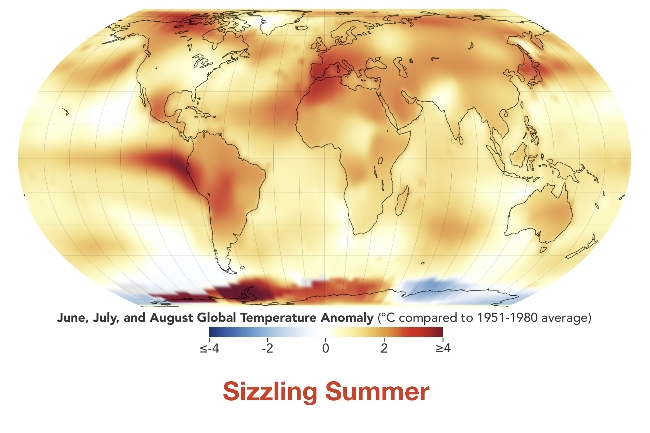With Earth’s Warmest Summer and August Now in the Record Books, What Will the Rest of 2023 Bring?
Posted on Categories Discover Magazine

Both NOAA and NASA have made it official: Earth sweltered through both the warmest August and most sizzling summer on record.
“Not only was last month the warmest August on record by quite a lot, it was also the globe’s 45th-consecutive August and the 534th-consecutive month with temperatures above the 20th-century average,” said NOAA Chief Scientist Sarah Kapnick, in a statement. “Global marine heat waves and a growing El Niño are driving additional warming this year, but as long as emissions continue driving a steady march of background warming, we expect further records to be broken in the years to come.”
Credit: NASA Earth Observatory
Gavin Schmidt, director of NASA’s Goddard Institute of Space Studies, echoed those comments in his own statement: “Unfortunately, climate change is happening. Things that we said would come to pass are coming to pass. And it will get worse if we continue to emit carbon dioxide and other greenhouse gases into our atmosphere.”
With some annual ups and downs, greenhouse gas emissions in the United States have generally been trending lower for the past 16 years, and that decline should accelerate, thanks to climate provisions in the Inflation Reduction Act. But globally, emissions are still growing, as is the concentration of carbon dioxide in the atmosphere. Over the long run, that does not bode well for the health of the planet — and our own well being.
The global average sea surface temperature reached a record high in March 2023 — and has stayed there ever since. With a growing El Niño, that is unlikely to change before the end of the year. (Credit: Climate Reanalyzer)
On a shorter timescale, sea surface temperatures began to soar in March, and have stayed at record high levels every day since then. On top of that, El Niño has grown quickly and now stands a greater than 70 percent chance of peaking as a strong episode this winter. (I’ll be publishing a column focusing on El Niño soon.)
Will 2023 Be a Record Warm Year?
During an El Niño — which is characterized by warm sea surface temperatures along the equator west of South America — the ocean releases heat into the atmosphere. This is why El Niño years have tended to be the warmest on record. And this year, we have the added impact of exceedingly warm ocean waters in most other areas of the globe.
In August of 1982, sea surface temperatures across most of the world’s oceans were cooler than the long-term average for 1971 through 2000. One notable exception: a spear of warm water along the equator west of South America — an early manifestation of what became one of the strongest El Niños on record. Forty-one years later, El Niño is present again. But otherwise, conditions are radically different, with exceedingly warm conditions dominating the world’s oceans overall. This has helped drive the globe to multiple record highs in 2023, including warmest summer. (Credit: Maps from Climate Reanalyzer. Animation by Tom Yulsman)
Given these and other factors, it is almost certain that 2023 will finish as the warmest year on record, surpassing 2016, according to NOAA. Astonishingly, that’s nearly double the odds that NOAA gave just a month ago.
“I’m rarely stunned by our findings,” said Deke Arndt, director of NOAA’s National Centers for Environmental Information, writing on X (the platform formerly known as Twitter). “Yesterday when the climate monitoring team briefed this, it took me five minutes just to process the magnitude.”